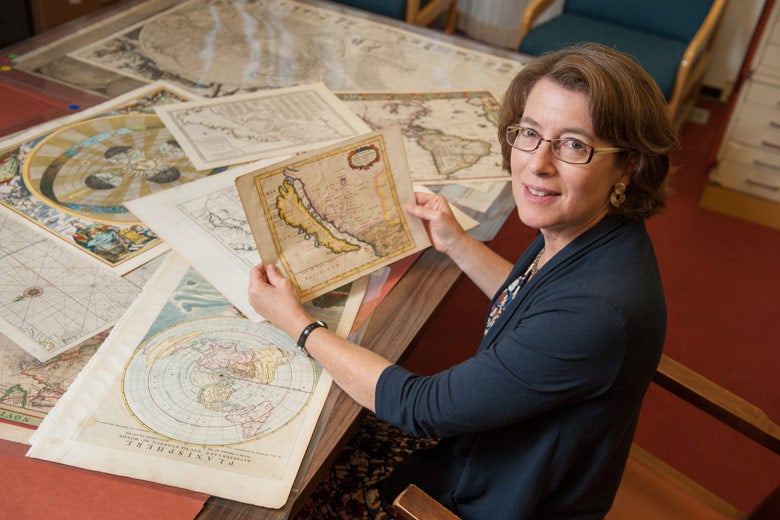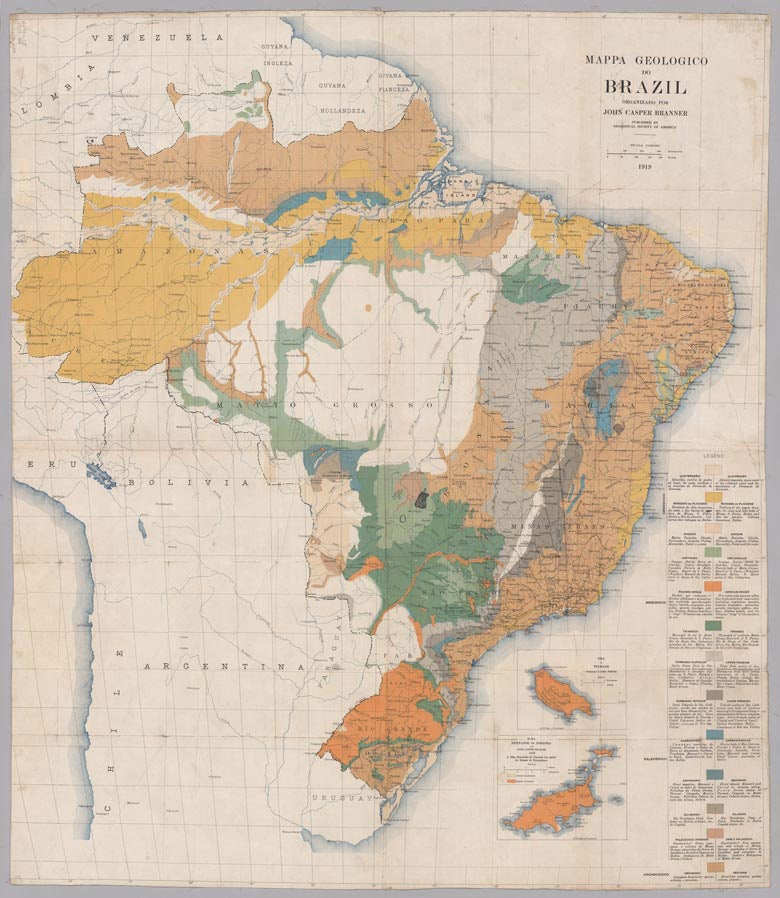
Julie Sweetkind-Singer, head librarian at Stanford’s Branner Earth Sciences Library & Map Collections, displays a map depicting California as an island. (Image credit: L.A. Cicero)
Centenarians are often asked to share the secrets of their longevity.
In the case of Stanford’s Branner Earth Sciences Library & Map Collections, which was founded 100 years ago, the task of answering that question falls to Julie Sweetkind-Singer, who has served as its head librarian since 2004.
Sweetkind-Singer said Branner Library has remained a vital and vibrant part of what is now the School of Earth, Energy & Environmental Sciences throughout the decades because it has evolved to meet the needs of successive generations of faculty and students by adopting new technologies and providing new services.
“We are working hard to remain at the forefront of what we think is important to support the scholarship of faculty and students by providing access to content and materials, and by offering workshops on how to use the geospatial data, digital map services and geographic information services of the Stanford Geospatial Center,” she said. “We are also preserving the research of faculty and graduate students in the Stanford Digital Repository, a long-term archive for scientific content.”
Sweetkind-Singer also cited EarthWorks, a new search engine that allows faculty and students to search for and download geospatial data from collections at Stanford and nine other universities, including Harvard, the Massachusetts Institute of Technology, and the University of California, Berkeley.
Two decades ago, librarians helped users overcome a scarcity of information, she said. In the digital age, they help them navigate “a veritable flood of information.”
“Our job has gone from people asking ‘how do I find one piece of information,’ to ‘how do I sift through all the information out there to find out what’s relevant to my work,’ ‘how do I know if a journal article or a conference proceeding or a webpage is relevant and credible,’ and ‘how do I know which database will be best for my research,'” Sweetkind-Singer said.

John Casper Branner, Stanford’s first geology professor, produced this geologic map of Brazil after numerous visits to the country between 1874 and 1883. (Image credit: Mappa geologic do Brazil, Geological Society of America, 1919, by John Casper Branner)
As the school became more interdisciplinary, so did the library, which now purchases materials on alternative energy, agriculture, soils, land use, water, climate change, hazards, and food and water security.
Staff members at Branner Library bring a broad array of expertise to support these endeavors. The staff includes five librarians, a biochemist, a geographer, an anthropologist, a technology specialist and three paraprofessionals.
The library, which is housed on the second floor of the Mitchell Earth Sciences Building, has about 125,000 volumes and 270,000 sheet maps.
Sweetkind-Singer said the library’s goal is to provide resources and information to the faculty and students in whatever form they need it, whenever and wherever they need it.
“When students are up at 2 o’clock in the morning and the library is closed, we now have a lot of electronic resources that are available for them,” she said. “When faculty and students are in the field doing research, or in their offices doing analysis and simulations, it’s important to find a way to get them the information they need.”
The Branner Library got its start as the private collection of John Casper Branner (1850-1922), the first geology professor at Stanford and its second president.
He shipped the collection from Arkansas, where he was serving as the state geologist, after accepting the job at Stanford.
Branner kept his collection in a large room next to his office in the Geology Corner of the Main Quad, and opened the stacks to students, faculty, alumni and all scientists. With his permission, they checked out books by signing a piece of paper fastened to the door. Branner’s part-time secretary, undergraduate student – and future U.S. president – Herbert Hoover, helped maintain the library.
In time, the collection spread beyond its original room. In Book Collectors of Stanford: An Eclectic Eight Who Shaped The Stanford University Libraries, John Y. Cole wrote: “The Stanford Alumnus reported that the books on petrography are with Professor Rogers in the petrography building, and those on mining and metallurgy are with Professor Folsom in the mining building.”
When Stanford bought the collection in 1915, it included more than 10,000 volumes and “an equal number of pamphlets and many maps.” It was considered one of the best private collections in geology and related sciences in the country.
Branner sold the collection to the university at cost – for $23,500.
The 100th anniversary celebration events, held in the spring quarter, included a map-a-thon, a discussion of an ingenious geologic map of Game of Thrones (the epic fantasy TV series), library tours and a panel discussion. The library created special exhibits of some of its treasures, including maps showing California as an island, and the first geological map of England, Wales, and southern Scotland, published in 1815 by William Smith.
The Stanford Band played at the party. Someone put a jaunty party hat and a glittery tie on the plaster bust of Branner that stands on a filing cabinet in the library.
A display case of memorabilia, including a photograph of Branner with Thomas Edison, and a copy of the inaugural address Branner delivered in 1913 when he became president of Stanford, remain on display in the library through the end of September.